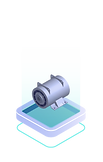
DATA CONNECTIONS
Turbit is able to connect to various Asset Management Systems (AMS) like:

Turbit then uses the historical and live data to start the monitoring. Additionally to the standard of 10 min average SCADA data Turbit uses status data and system logs to prioritize and filter events generated by Turbit.
If you don't use an AMS Turbit also connects directly (Direct Connection) to the wind park via:
If you connect Turbit via a Direct Connection you can get and store up to 1s values. You can read about the advantages of this approach here.
If you have your own database solution we can either directly connect to your database or you can push data to us.
This is easily done via Turbit's API. The data can be complete and you just need to create a client that connects to the Turbit API and pushes a JSON object. Turbit then does the rest automatically. This is very useful if you have unique data, that is not accessible via the AMS.
All historical data from different sources is then easily reachable via Turbit's API. You can create your own scripts or connect other third parties easily to Turbit.
You can read more about the Turbit API and its applications and capabilities here.
Together with Turbit's partners, you can also integrate vibrational blade data and CMS data into the AI monitoring of Turbit.
DATA REQUIREMENTS
Turbit is training neural networks for each of the monitored components. Depending on which modules of Turbit you have activated there are different data requirements. You can read each requirement in the product descriptions or get a general overview here.
Turbit is using external weather data and other data sources to enrich the provided data. This way the best accuracy of the prediction models is ensured. However, original on-site data generates the best and highest quality for Turbit AI Monitoring and is thus recommended. Providing Turbit with high-frequency data like 1-minute average data or higher time resolutions adds to the accuracy of the monitoring.
AI POWER MONITORING
Minimum required:
-
Windspeed (10 min. average)
-
Power
Optionally required:
-
Wind Direction
-
Windspeed (Standard Deviation) Orientation Nacelle
-
Outside Temperatures
-
Humidity
-
Precipitation
-
Status Codes
If you provide 1-minute average values or higher much better accuracies are achieved.

AI GEARBOX, GENERATOR AND MAIN
BEARING MONITORING
Minimum required:
-
Outside Temperatures
-
Power
-
Minimum 1 of the following:
-
Main Bearing temperatures
-
Gearbox bearing temperatures
-
Generator bearing temperatures
-
Oil temperatures
-
Temperatures of cooling systems
-
Optionally required:
-
Rotor speed
-
Pitch Angles
-
Oil Pressures
-
Status Codes
If you provide 1-minute average values much better accuracies can be achieved.


